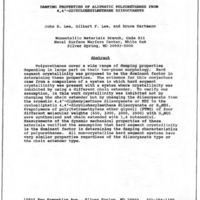-
Title
-
Damping Properties Of Aliphatic Polyurethanes From 4,4'-Dicyclohexylmethane Diisocyanate
-
Report Number
-
WL-TR-91-3078 Volume III, p. GDF-1 thru GDF-12
-
Creator
-
Lee, John D.
-
Lee, Gilbert F.
-
Hartmann, Bruce
-
Corporate Author
-
Nonmetallic Materials Branch, Code R31, Naval surface Warfare Center
-
Date
-
1991
-
Date Issued
-
1991-08
-
Extent
-
12
-
Identifier
-
ADA241313
-
Format
-
1 online resource
-
Abstract
-
Polyurethanes cover a wide range of damping properties
depending in large part on their two-phase morphology. Hard segment crystallinity was proposed to be the dominant factor in determining these properties. The evidence for this conjecture came from a comparison of a system in which hard segment crystallinity was present with a system where crystallinity was inhibited by using a different chain extender. To verify our assumption, in this work crystallinity was inhibited not by changing the chain extender but by changing the diisocyanate from the aromatic 4,4'-diphenylmethane diisocyanate or MDI to the cycloaliphatic 4,4'-dicyclohexylmethane diisocyanate or H12MDI. Prepolymers of poly{tetramethylene ether glycol) {PTMG) of four different molecular weights {650, 1000, 2000, 2900) with H12MDI were synthesized and chain extended with 1,4 butanediol. Measurements of the dynamic mechanical properties of these materials verified the assumption that hard segment crystallinity is the dominant factor in determining the damping characteristics of polyurethanes. All non-crystalline hard segment systems have very similar properties regardless of the diisocyanate type or the chain extender type.
-
Description
-
Polyurethanes cover a wide range of damping properties
depending in large part on their two-phase morphology. Hard segment crystallinity was proposed to be the dominant factor in determining these properties. The evidence for this conjecture came from a comparison of a system in which hard segment crystallinity was present with a system where crystallinity was inhibited by using a different chain extender. To verify our assumption, in this work crystallinity was inhibited not by changing the chain extender but by changing the diisocyanate from the aromatic 4,4'-diphenylmethane diisocyanate or MDI to the cycloaliphatic 4,4'-dicyclohexylmethane diisocyanate or H12MDI. Prepolymers of poly{tetramethylene ether glycol) {PTMG) of four different molecular weights {650, 1000, 2000, 2900) with H12MDI were synthesized and chain extended with 1,4 butanediol. Measurements of the dynamic mechanical properties of these materials verified the assumption that hard segment crystallinity is the dominant factor in determining the damping characteristics of polyurethanes. All non-crystalline hard segment systems have very similar properties regardless of the diisocyanate type or the chain extender type.
-
Distribution Classification
-
1
-
Distribution Conflict
-
No
-
DTIC Record Exists
-
No
-
Illinois Tech Related
-
No
-
Photo Quality
-
Not Needed
-
Report Availability
-
Full text available
-
Type
-
article
 articleGDF
articleGDF